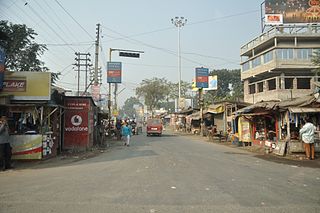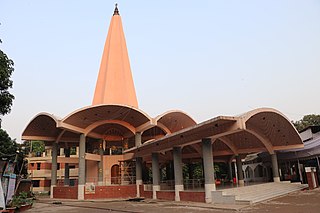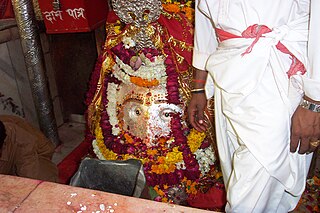
Shaktism is a major Hindu denomination in which the godhead or metaphysical reality is considered metaphorically to be a woman.

Durga Puja, also known as Durgotsava or Sharodotsav, is an annual festival originating in the Indian subcontinent which reveres and pays homage to the Hindu goddess Durga, and is also celebrated because of Durga's victory over Mahishasura. It is particularly celebrated in the Eastern Indian states of West Bengal,Tripura, Bihar, Jharkhand, eastern Uttar Pradesh, Assam, Odisha and by Hindus in Bangladesh. The festival is observed in the Indian calendar in the month of Ashvin, which corresponds to September–October in the Gregorian calendar. Durga Puja is a ten-day festival, of which the last five are of the most significance. The puja is performed in homes and public, the latter featuring a temporary stage and structural decorations. The festival is also marked by scripture recitations, performance arts, revelry, gift-giving, family visits, feasting, and public processions called a melā. Durga Puja is an important festival in the Shaktism tradition of Hinduism. Durga Puja in Kolkata has been inscribed on the intangible cultural heritage list of UNESCO in December 2021.

Dhakeshwari National Temple is a Hindu temple in Old Dhaka, Dhaka, Bangladesh. It is state-owned, giving it the distinction of being Bangladesh's 'National Temple'. The name "Dhakeshwari" means "Goddess of Dhaka". Bangladesh is the only country in the World to have a National Hindu Temple. It's one of the holiest Shakta pithas where the gem of Devi sati's crown fell but the gem is lost long ago and the main ancient Vigraha or stone murti is relocated to Kumortuli West Bengal during the partition time by the chief priest due to increased attacks on Hindu temples in Bangladesh.

Dakshineswar Kali Temple or Dakshineswar Kalibari is a Hindu navaratna temple in Dakshineswar, Kolkata, West Bengal, India. Situated on the eastern bank of the Hooghly River, the presiding deity of the temple is Bhavatarini (Kali), a form of Mahadevi or Parashakti Adya Kali, otherwise known as Adishakti Kalika. The temple was built in 1855 by Rani Rashmoni, a Zamindar, philanthropist and a devotee of Kali Maa. The temple is known for its association with Ramakrishna and Ma Sarada Devi, mystics of 19th century Bengal.

Bardhaman, officially Bardhaman Sadar, is a city and municipality in the state of West Bengal, India. It is the headquarters of Purba Bardhaman district, having become a district capital during the period of British rule. Burdwan, an alternative name for the city, has remained in use since then.

Jagatdhatri or Jagaddhatri is an aspect of the Hindu goddess Durga, worshipped in the Indian state of West Bengal and other states like Odisha and Jharkhand. Jagaddhatri Puja is particularly famous in Chandannagar town of Hooghly district,Krishnanagar of Nadia district and Ichhapur Nawabgunj of North 24 Parganas in West Bengal where it is celebrated as a five-day-long festival. Her worship and rituals are derived from Tantra. It is believed that her worship frees her devotees from ego and all other materialistic desires.
Kolkata has many festivals throughout the year. The largest and most magnificently celebrated festival of the city is Durga Puja, and it features colourful pandals, decorative idols of Hindu goddess Durga and her family, lighting decorations and fireworks. Other major festivals are Diwali, Kali Puja, Holi, Saraswati Puja, Poush Parbon, Poila Boishakh, Christmas, Eid al-Fitr, Eid al-Adha, etc.

Chittaranjan Park is an upscale neighborhood in South East Delhi and home to a large Bengali community. It was established on a rocky terrain in the early 1960s under the name EPDP Colony and later renamed after the deshbandhu (patriot) Chittaranjan Das in the 1980s. Nowadays it is considered among the posh localities in South Delhi due to a rise in the market price of its plots. Despite its growing cosmopolitan nature, it remains home to a large Bengali community and is home to Kolkata-style street-food stalls, Bengali cuisine, fish markets, temples, and cultural centers. It hosts many festivities and cultural events. Durga Puja is the most celebrated festival here which boasts magnificent marquee.

Chakdaha is a town and a municipality in the Kalyani subdivision of the Nadia district, located in the state of West Bengal, India.

The Ramna Kali Mandir is a temple in Dhaka that was originally built in the time of the Mughal Empire. It was also known as the "Ramna Kalibari". The temple is dedicated to the Hindu Goddess Kali.

Kalkaji Mandir, is a Hindu Temple, dedicated to the Hindu Goddess Kali. It is situated in southern Delhi, in Kalkaji, India, a locality that has derived its name from the temple and is located opposite the Nehru Place and close to the Okhla railway station, Kalkaji Mandir metro station. Hindus believe that the image of the Goddess Kalka here is a self-manifested one.

Chhatarpur Temple is a Hindu temple dedicated to the goddess Katyayani. The entire complex of the temple is spread over a wide area of 28 hectares. It is located in Chhatarpur, on the southwestern outskirts of the New Delhi. It is the 2nd largest temple in Delhi, after the Akshardham Temple. This temple is constructed from marble and on all of the facets there is jaali work. It can be classified a vesara style of architecture.

Delhi Durga Puja Samiti, also known as the Kashmere Gate Durga Puja is the oldest community Durga Puja (festival) of Delhi. It is currently held in the lawns of Bengali Sr Sec School, Alipur Road, Delhi. It started in the year of 1910 at Roshanpura Kali Mandir near Nai Sarak as "Baroyari Puja". It was an effort on the part of the probasi (settled) Bengalis living in the city, especially, of one Railway Doctor Hemchandra Sen. Subsequently, Lala Lachminarayan & his son Lala Girdhari Lal helped the puja samiti grow by providing them space in their Dharamshala located near Fathepuri Mosque.

Kali Puja, also known as Shyama Puja or Mahanisha Puja, is a festival originating from the Indian subcontinent, dedicated to the Hindu goddess Kali. It is celebrated on the new moon day of the Hindu calendar month of Ashwayuja or Kartika. The festival is especially popular in the region of West Bengal, and other places like Mithila, Jharkhand, Odisha, Assam, and Tripura, as well as the town of Titwala in Maharashtra, along with the neighbouring country of Bangladesh.
New Delhi Kali Bari is a Hindu temple dedicated to Goddess Kali and the center for Bengali culture in New Delhi, India. Established in 1930s, it is situated on Mandir Marg, close to Laxminarayan Temple in Delhi.

Suri is a city and a municipality in the Indian state of West Bengal. It is the headquarters of the Birbhum district.

The Hyderabad Kalibari is a Hindu temple located in the Vivekanandapuram, Neredmet neighbourhood of Hyderabad, 7 km from Secunderabad Railway Station, Telangana,India. The presiding deity of the temple is goddess Kali, hence the name Kalibari or Abode of Kali. The temple is famous for its Kali Puja and Durga Puja which is held on October/November of every year during Dusshera and Diwali.
Kali Bari Chhindwara is a temple dedicated to Goddess Kali and the center of Bengali culture in Chhindwara, India. Established in 1995, the deity in the temple is Maa Kali.

Maluti temples are a group of 72 extant terracotta temples, located in the Maluti village near Shikaripara in Dumka district on the eastern part of the Chota Nagpur Plateau, Indian state of Jharkhand. These temples, according to the Indian Trust for Rural Heritage and Development (ITRHD), were built between the 17th and 19th centuries. The kings of Baj Basanta dynasty built these temples in Maluti, their capital, inspired by goddess Mowlakshi, their family deity. Many of the temples are deified with different denominations of gods and goddesses, apart from the tutelary deity Mowlakshi, and others such as Shiva, Durga, Kali and Vishnu. The Global Heritage Fund (GHF) has proposed a conservation effort, which would increase tourism to the Maluti village. GHF has declared this site as one of the world's 12 most endangered cultural heritage sites.

The Indian state West Bengal has a rich cultural heritage. Due to the reign of many different rulers in the past, arts and crafts in West Bengal underwent many changes giving an artistic diversity today in the forms of traditional handicrafts, terracotta, painting and carving, dances and music.























